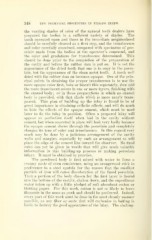Page 690 - My FlipBook
P. 690
348 THE TECHNICAX, PEOCEDUKES IN FILLING TEETH.
the varying shades of color of the natural teeth dealers have
prepared the bodies in a sufficient variety of shades. The
tooth operated upon and those in the immediate neighborhood
should be carefully cleaned as a first step, and the translucence
and color carefully examined, compared with specimens of por-
celain made from the bodies at the operator's command, and
the color and gradations for translucence determined. This
should be done prior to the completion of the preparation of
the cavity and before the rubber dam is put on. It is not the
appearance of the dried tooth that one is to copy in the poi'ce-
lain, but the appearance of the clean moist tooth. A tooth well
dried with the rubber dam on becomes opaque. One of the prin-
cipal points in obtaining the proper translucence is to use the
more opaque color first, bake or biscuit this separately, then add
the more translucent colors in one or more layers, finishing with
the enamel body; or in those preparations in which no enamel
body is provided, with that shade which is more nearly trans-
parent. This plan of building up the inlay is found to be of
great importance in obtaining esthetic effects, and will do much
to hide the effects of the opaque cement, which must be used
later to fix the inlay in position. Often a prepared inlay will
appear as perfection itself when laid in the cavity without
cement, but when cemented in place will look vei"y badly because
the opaque cement shows through the porcelain and completely
changes its tone of color and translucence. In this regard very
much may be done by a judicious arrangement of the cavity
walls and margins, especially by such an arrangement as will
place the edge of the cement line toward the obsen'er. No fixed
rules can yet be given in words that will give much valuable
information in this building-up process in making porcelain
inlays. It must be obtained by practice.
The powdered body is first mixed with water to form a
creamy paste of even consistence, using an orangewood stick in
preference to a steel spatula for the reason that the smallest
particle of iron will cause discoloration of the fused porcelain.
Then a portion of the body chosen for the first layer is flowed
into the bottom of the matrix, shaken down, and the superfluous
water taken up with a little pledget of soft absorbent cotton or
blotting paper. For this work, cotton is not so likely to leave
filaments in the mass as punk and should be preferred. Indeed,
every part of this work must l)e done in tlie most cleanly manner
possible, as any fiber or mote that will carbonize in baking is
liable to destroy the good appearance of the inlay. The shaking-


